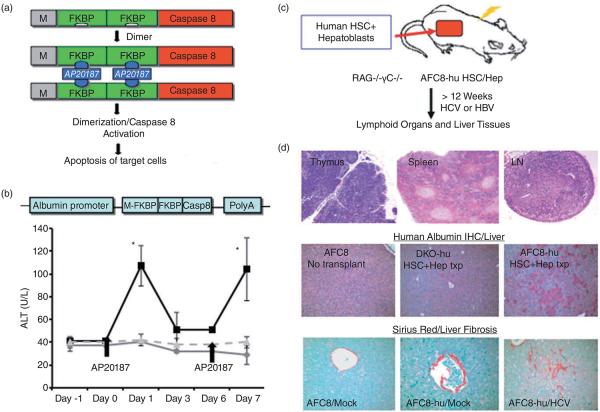Figure 1.
AFC8-hu Hep/hematopoietic stem cell (HSC) mice support engraftment of human immune/liver cells and hepatitis C virus (HCV) infection. (a) Inducible activation of caspase 8 through dimerization of FK506-binding protein (FKBP)-caspase 8. The chemical dimerizer AP20187 leads to activation of caspase 8 and apoptosis. (b) Mouse liver injury can be repeatedly induced in AFC8 transgenic mice. AFC8 or littermate control mice were injected with AP20187 at day 0 and day 6. ALT was measured in serum at −1, 0, 1, 3, 6, and 7 days postdrug treatment. Data represent means ± SD, P < 0.05. ( ) Control; (
) Control; ( ) APC8; (
) APC8; ( ) APC8 no drug. (c) Construction of AFC8-hu HSC/Hep mice with human CD34+ HSC and EpCAM+ hematoblasts. (d) Lymphoid organs including thymus, spleen, and lymph node (LN) are shown to demonstrate human immune cell reconstitution (top). Liver sections from control mice without transplant (left) and both control (middle) and AFC8 (right) transplanted with human HSC/Hep (AFC8-hu HSC/Hep) were stained with antihuman albumin antibody. Human albumin positive cells are shown (Middle). AFC8-hu HSC/Hep mice develop liver fibrosis after HCV infection (bottom). Liver sections from AFC8/mock, AFC8-hu/mock, and AFC8-hu/HCV mice were stained with sirius red/fast green to visualize liver fibrosis (red).
) APC8 no drug. (c) Construction of AFC8-hu HSC/Hep mice with human CD34+ HSC and EpCAM+ hematoblasts. (d) Lymphoid organs including thymus, spleen, and lymph node (LN) are shown to demonstrate human immune cell reconstitution (top). Liver sections from control mice without transplant (left) and both control (middle) and AFC8 (right) transplanted with human HSC/Hep (AFC8-hu HSC/Hep) were stained with antihuman albumin antibody. Human albumin positive cells are shown (Middle). AFC8-hu HSC/Hep mice develop liver fibrosis after HCV infection (bottom). Liver sections from AFC8/mock, AFC8-hu/mock, and AFC8-hu/HCV mice were stained with sirius red/fast green to visualize liver fibrosis (red).

